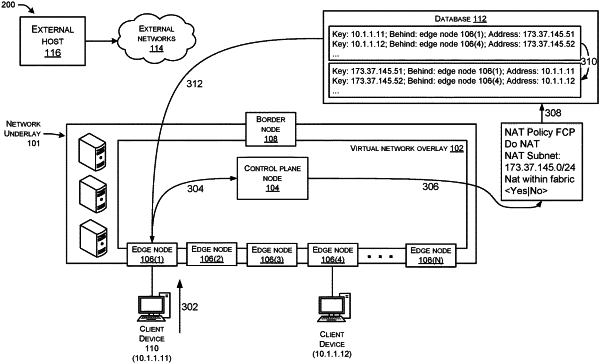| CPC H04L 61/2557 (2013.01) [H04L 12/4633 (2013.01); H04L 12/4679 (2013.01); H04L 51/04 (2013.01); H04L 61/2575 (2013.01); H04L 61/2592 (2013.01); H04L 61/5038 (2022.05)] | 20 Claims |

|
1. A physical server disposed in an underlay of physical servers that execute a virtual network overlay, the physical server comprising:
one or more processors; and
one or more non-transitory computer-readable media storing computer-executable instructions that, when executed by the one or more processors, cause the one or more processors to:
establish, by a first edge node of the virtual network overlay, a connection to a client device having a device address;
send, by the first edge node, a first registration message to a control plane node of the virtual network overlay;
look up, by the control plane node, a network address translation (NAT) policy;
assign, by the control plane node, a subnet address to the client device as a NAT address based on the NAT policy;
record, by the control plane node, a first mapping and a second mapping between the device address and the assigned NAT address, each of the first mapping and the second mapping being associated with the first edge node;
send, by the control plane node, a confirmation message to the first edge node indicating the first mapping and the second mapping between the device address and the NAT address;
establish, by a second edge node of the virtual network overlay, a connection to the client device;
send, by the second edge node, a second registration message to the control plane node, the first registration message and the second registration message respectively comprising a same Endpoint ID (EID) of the client device; and
update, by the control plane node, each of the first mapping and the second mapping from being associated with the first edge node to being associated with the second edge node.
|